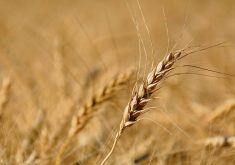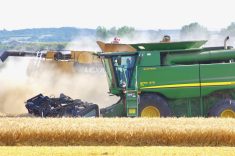CNS Canada — Prices for canary seed over the last 15 months have fluctuated between 20 and 23 cents/lb. delivered in Western Canada, and there’s little chance that will change any time soon.
To David Nobbs, managing partner of Canpulse Foods in Saskatoon and a director with the Canaryseed Development Commission of Saskatchewan, the canary seed market has not changed much for quite some time.
“It’s a very dull market. It’s been like this for a number of years. We had a couple of spurts in the fall, and the fall prices have been the high mark for the whole year,” he said.
Read Also

U.S. grains: CBOT soybeans, corn, wheat fall in USDA data aftermath
Chicago grains took a dive on Friday, following a closely watched U.S. government crop report and the release of export data that could provide clues into Chinese buying.
While there is a small demand for hairless varieties of canary seed for human consumption, CDCS executive director Kevin Hursh said that aspect does not affect the market very much. Itchy varieties are grown for birdseed.
“This is almost a market that’s driven entirely by birdseed demand, and that tends to be a pretty static demand,” he said, adding most of Canada’s canary seed exports go to Mexico and Europe.
Nobbs said the delays to the fall harvest “stirred prices up a bit” and pushed them to 24 cents, until more of the crop came off the fields and prices settled to 22 to 23 cents/lb.
Even when the loonie loses strength, that doesn’t solve much, he said.
“Our slightly weaker Canadian dollar is helping, but the (Mexican) peso and the euro are at super weak levels too, and those two regions take half of the canary in the world.”
Saskatchewan is Canada’s leading producer of canary seed with 145,000 tonnes in 2017, according to Statistics Canada. This year, however, Saskatchewan’s production dropped by nearly a third to 98,800 tonnes.
That was still more than 89 per cent of all the canary seed grown in Canada. Crops elsewhere in the country were either too small to provide data or numbers were withheld to meet the confidentiality requirements of the Statistics Act.
Canary seed production dropped in 2018 because other prices, such as durum, looked better at the time farmers were deciding what to plant, Hursh said.
“I think if people would have known how poorly durum prices were going to do, that probably would have changed decisions resulting in more canary seed acres,” he said.
Nobbs said he distrusts Statistics Canada’s data and believes Saskatchewan continues to produce 140,000 to 150,000 tonnes of canary seed year after year.
Statistics Canada releases its updated production estimates on Dec. 6.
— Glen Hallick writes for Commodity News Service Canada, a Glacier FarmMedia company specializing in grain and commodity market reporting.















